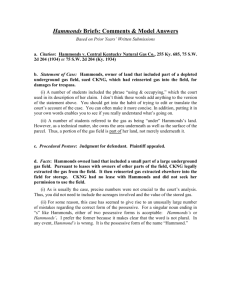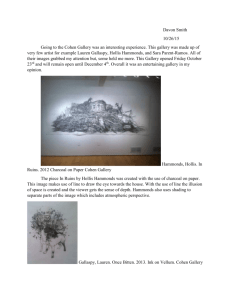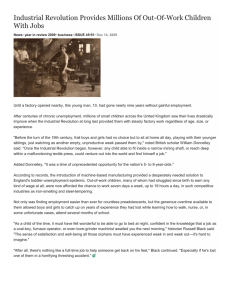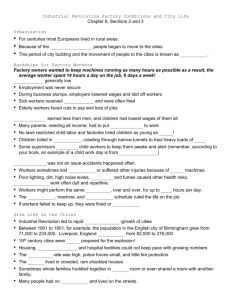Unpacking Historical Writing: The Use of Literary Devices in The
advertisement
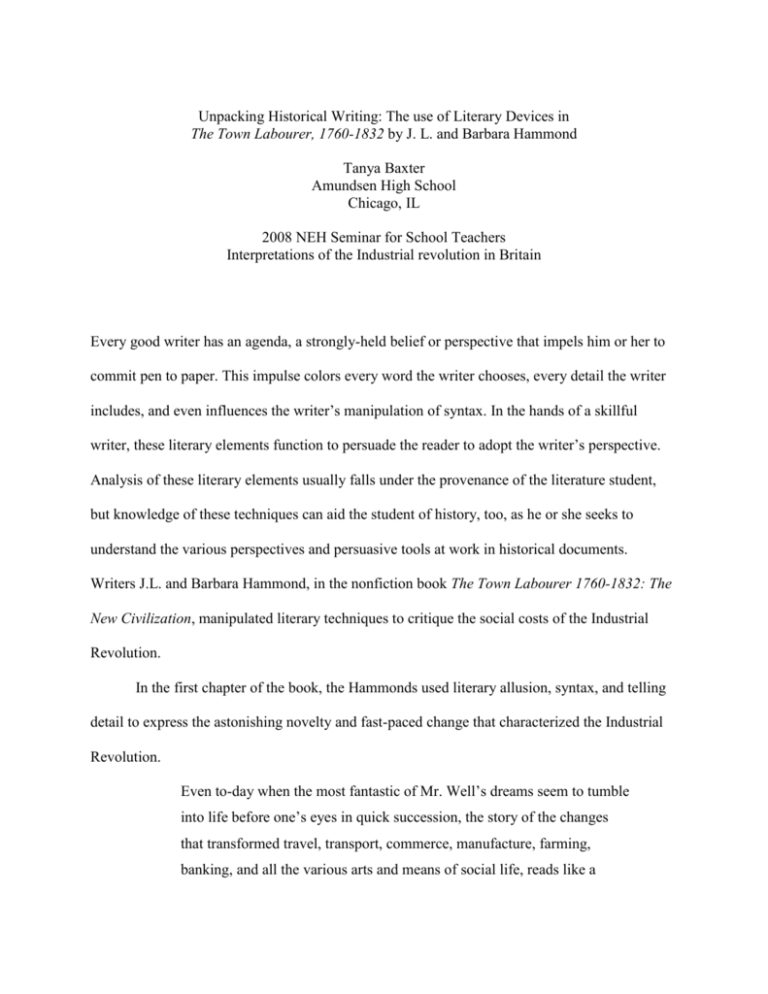
Unpacking Historical Writing: The use of Literary Devices in The Town Labourer, 1760-1832 by J. L. and Barbara Hammond Tanya Baxter Amundsen High School Chicago, IL 2008 NEH Seminar for School Teachers Interpretations of the Industrial revolution in Britain Every good writer has an agenda, a strongly-held belief or perspective that impels him or her to commit pen to paper. This impulse colors every word the writer chooses, every detail the writer includes, and even influences the writer’s manipulation of syntax. In the hands of a skillful writer, these literary elements function to persuade the reader to adopt the writer’s perspective. Analysis of these literary elements usually falls under the provenance of the literature student, but knowledge of these techniques can aid the student of history, too, as he or she seeks to understand the various perspectives and persuasive tools at work in historical documents. Writers J.L. and Barbara Hammond, in the nonfiction book The Town Labourer 1760-1832: The New Civilization, manipulated literary techniques to critique the social costs of the Industrial Revolution. In the first chapter of the book, the Hammonds used literary allusion, syntax, and telling detail to express the astonishing novelty and fast-paced change that characterized the Industrial Revolution. Even to-day when the most fantastic of Mr. Well’s dreams seem to tumble into life before one’s eyes in quick succession, the story of the changes that transformed travel, transport, commerce, manufacture, farming, banking, and all the various arts and means of social life, reads like a 2 chapter of Arabian Nights. The blind Metcalf had introduced the art of making roads; the illiterate Brindley, the art of building aqueducts; Telford, a shepherd’s son, had thrown a bridge across the Menai Straits; Bell, a millwright’s apprentice, had launched the first steamer on the Clyde; Stephenson, the son of a fireman, had driven his first railway engine; while a long line of inventors and organizers—Watt, Arkwright, Wedgwood, Crompton, Hargreaves and a hundred others—by their patience and their courage and their imagination, had between them made England the workshop of the world. (1-2) The changes wrought by the Industrial Revolution were magical—like an H.G. Wells novel, they seemed to “tumble” from some unimagined future, and they were as exotic as the tales of Sheherezade. And what was even more astonishing was the fact that these changes were dreamed up by ordinary men. The Hammonds manipulated syntax to emphasize the scope of the accumulated changes, brought about by men of ordinary circumstances, that changed an agrarian world into an industrial one. There are only two sentences in this passage; the second is lengthened by the use of semicolons. In this second sentence, the Hammonds used these semicolons to connect all of the different inventions and improvements, performed by men from all over England, to elaborate upon the idea of the mystifying pace of change. The use of the semicolon acknowledges that these changes were independent of each other, but also yokes the changes together, each a part of a single, larger process. The semicolons also affect the pacing of the sentence. Rather than present the reader with a series of short, choppy sentences, the Hammonds built a rhythm that emphasizes a second dash and leads us to the effect of all of these accumulated changes—England became the “workshop to the world.” But what did the Hammonds think of these men? Their use of epithet, an adjective before a name, and patronymic, reference to the father before or after a name, is telling. The use of epithets and patronymics as 2 3 literary devices go back at least as far as Ancient Greece, when Homer used these techniques to describe heroes, gods, and monsters. The Hammonds evoked “illiterate Brindley” and “blind Metcalf”, using as epithets what some would consider weaknesses, but the literary effect is quite the opposite. Brindley may have been illiterate, but he still built aqueducts; Metcalf may have been blind, but he taught the English how to make roads. The Hammonds wanted us to know that these were strong men. Similarly, the use of patronymic also emphasizes the power of these regular people. Telford may have only been the son of a shepherd, but he could still throw a bridge like a god. Stephenson may have only been the son of a fireman, but he could still harness the power of steam. By using epithet and patronymic, the Hammonds connected these innovators to the epic heroes of the past, and ennoble their work. But there are other effects of the Industrial Revolution, social effects, and the Hammonds used literary techniques to critique the effect of the factory on the workers’ sense of time and agency, and therefore their quality of life. The Hammonds described this change as a new discipline (20). They wrote, . . . we have to remember that the population that was flung into the brutal rhythm of the factory had earned its living in relative freedom, and that the discipline of the early factory was particularly savage. To understand what this discipline meant to men, women, and children, we have to remember too that poor people rarely had a clock in the house. Sadler said that you could hear the feet of children pattering along the dark streets long before the time for the mills to open. No economist of the day, in estimating the gains and losses of factory employment , ever allowed for the strain and violence that a man suffered in his feelings when he passed from a life in which he could smoke or eat, or dig or sleep as he 3 4 pleased, to one in which somebody turned the key on him, and for fourteen hours he had not even the right to whistle. (20-21) In this passage, the use of diction is particularly powerful. The factory rhythm is “brutal” and therefore relentless, and the discipline required of the workers is “savage”. The use of these words implies that the workers have lost their humanity and the veneer of a civilized life as a result of the Industrial Revolution. The Hammonds juxtaposed the economists’ concerns for “gains and losses” with the “strain and violence” on the emotions of the workers as their freedoms were curtailed. They further downplayed the economic concerns by elaborating on the workers’ vanishing freedoms as a kind of pastoral ideal. What is so bad about smoking, eating, digging, or sleeping when you want? Under the factory system, the Hammonds made clear, the workers lost all agency and were little better than animals that are locked in cages, and worse off, perhaps, because they cannot even whistle. Finally, the use of imagery is designed to tug at the reader’s heartstrings as the Hammonds described the “pattering” of the factory children’s feet as they rush through the darkness to get to work on time. The Hammonds used literary devices to effectively illustrate the inhuman working and living conditions in the factory towns. Workers’ surroundings left little room for the imagination: “In their work they had none of the excitement or pleasure of handicraftsmen; they worked among ugly things, in ugly factories or ugly mines, for though an engine or a wheel may have a noble beauty and design, its beauty is obscured for those who are tending one small part of it and doing nothing else” (39). In this short passage, the Hammonds used repetition for emphasis: there was absolutely no room for aesthetic pleasure in the workers’ lives. Even if they work on something that will eventually result in a beautiful object, they are only allowed to work on a 4 5 small part of it. To the Hammonds, this was one of the evils of the factory system. They quoted from a Trade Union magazine to further illustrate the poverty of the factory workers’ daily lives: ‘Have we not seen the commons of our fathers enclosed by insolent cupidity—our sports converted into crimes—our holidays into fast days? The green grass and the healthful hayfield are shut out from our path. The whistling of birds is not for us—our melody is the deafening noise of the engine. The merry fiddle and the humble dance will send us to the treadmill. We eat the worst food, drink the worst drink—our raiment, our houses, our everything, bear signs of poverty, and we are gravely told that this must be our lot.’ (45) The power of this passage lies in the juxtaposition of ideas and images. The workers’ innocent pastimes were illegal; their feast days were now times of scarcity. Rather than the sound of birds, they were allowed only the “deafening” engine. The fiddle and the dance are replaced by the repetitive labor represented by the treadmill. Everything around them is substandard, and when they complain, the workers are told that this is just the way it is; they are condescended to. In a later section, the Hammonds made use of allusion and juxtaposition to condemn the use of child labor and illustrate the economic and social disparities that help fuel the Industrial Revolution. They wrote: It requires an effort as we think of the children in the mill, punished with the punishment of Sisyphus for the pleasures of a life they had never tasted, and of the children in the mines, keeping their blind vigil before the sun had risen, and keeping their blind vigil after the sun had set, to remember that this was an age in which childhood and all the promise and mystery of childhood were taking a new place in the affections of the 5 6 cultivated classes . . . Charles and Mary Lamb were publishing Poetry for Children and the Tales From Shakespeare . . . The greatest portrait painter of the age was describing the charm and grace and laughter of happy and careless childhood. But so deep and distant was the underworld where children were stolen from the sunshine as soon as they could creep beneath an engine or watch a trap-door in a mine, that the sleep of those rulers who admired Sir Joshua’s portraits of innocence, and took pride in their sensibility and tenderness, was never broken or haunted by an echo of the ‘Voces, vagitus et ingens Infantumque animae flentes in limine primo, Quos dulcis vitae exsortes et ab ubere raptos Abstulit atra dies.’ (192-193) The Hammonds made frequent reference to Greek and Roman mythology in this excerpt to illustrate their points. They compared the work of the children in the mills to the punishment of Sisyphus, who was condemned to push a stone up a hill for all of eternity. This comparison emphasizes the monotonous, boring, and punishing nature of the children’s work. The children who work in the mines are deprived of sensory experience because their “blind vigil” keeps them underground from before dawn until the sun has set; they were in effect like Persephone, who also was “stolen” from the sunshine and forced to live in the underworld. But while Persephone’s abduction was suffered for by all, the children of the mines and factories did not disturb the rest of the privileged. These children were buried so deep that the fortunate never heard their cries. The Hammonds used a quote from Virgil to compare these children of the Industrial Revolution to the babies who weep on the threshold of Hades, the babies who can never be saved, and so emphasized the hopelessness of their lives: they are already dead. But their experiences were not shared by all. The Hammonds made use of allusions more current to the Industrial Revolution to 6 7 juxtapose the very different experiences of the children of privilege and the children of the working class. While poor children were punished like Sisyphus or condemned to Hades, the more fortunate children were reading books written especially for them, and having their portraits painted by Sir Joshua Reynolds. In a time when, thanks to Rousseau, the idea of childhood as a stage to be nurtured and valued was taking hold of the popular imagination, “the charm and grace and laughter of happy and careless childhood” was a condition enjoyed only by one segment of the British population. But the reality was that the children of the working class were not in Hades, the Hammonds imply, they were right here on Earth, and the reason why the “rulers” were not “haunted” by the echoes of their sufferings is because they chose not to be, they turned a deaf ear. Their pleasures were bought at the expense of the workers. The Hammonds quoted a passage rich with evocative diction and imagery from The Mendip Annals, written by Hannah and Martha More, to illustrate the prejudiced views some evangelicals held of the working class, even while they hoped to save and help them. The More sisters visited a glassblowing factory, and this was their report: ‘Both sexes and all ages herding together: voluptuous beyond belief . . . The wages high, the eating and drinking luxurious—the body scarcely covered, but fed with dainties of a shameful description. The high buildings of the glass-houses ranged before the doors of the cottages—the great furnaces roaring—the swearing, the eating and drinking of these half-dressed, black-looking beings gave it a most infernal and horrible appearance. One, if not two, joints of the finest meat were roasting in each of these little hot kitchens, pots of ale standing about, and plenty of early delicate-looking vegetables.’ (227) 7 8 Clearly, the More sisters believed the glassblowers were all going to Hell—their use of diction and imagery makes this obvious. First of all, the workers were too self-indulgent. The interaction between men and women was “voluptuous.” Their drinking was ‘luxurious.” They did not eat good, solid peasant food, but feasted on “dainties of a shameful nature,” “the finest meat,” and “plenty of early delicate-looking vegetables.” One wonders if the More sisters would fault members of the aristocracy or the middle-class for such a diet, and if they would not, then the sin of the glassblowers lies in eating better than they deserve. In fact, the More sisters viewed these workers as somewhat less than human, perhaps animals or demons already. The glassblowers did not gather; they met in herds. They lived surrounded by the roaring of furnaces as “half-dressed, black looking beings” so that their homes had an “infernal” appearance. The Hammonds chose this quote to illustrate the unsympathetic nature that many evangelicals had towards the working classes that they were pledged to aid and support. The More sisters were so interested in saving the workers’ souls that they begrudged them any creature comforts. In the very last paragraph of the book, the Hammonds used diction and imagery to express their horror at the long lasting effects of the Industrial Revolution. . . .the new system grew up, almost without challenge or protest, in the atmosphere of a discipline as rigorous as that of any army, for it seemed to the possessing classes that any acknowledgements of human rights would imperil its power, and even its existence. Hence it was that amid all the conquests over nature that gave its triumphs to the Industrial Revolution, the soul of man was passing into a colder exile, for in this new world, with all its wealth and promise and its wide horizon of mystery and hope, the spirit of fellowship was dead. (329) 8 9 The world created by the Industrial Revolution is fundamentally different from any that has come before. The imagery that the Hammonds used to express this is imperialistic in nature: the factory system required “a discipline as rigorous as that of an army” and achieved “conquests over nature” to create a “new world”. And what of the old ways? The hope for satisfaction, family feeling, and the experience of beauty? These experiences—the soul of our humanity— were likened metaphorically to a vanquished race that must pass into a “colder exile” to be forgotten forever because “the spirit of fellowship was dead.” From the Hammonds’ point of view, the connections of mutual obligation between people of different classes that had defined life in Great Britain for centuries had been unraveled by the impact of the Industrial Revolution. No one could deny that the Hammonds were intensely critical of the social costs of the Industrial Revolution. But could one look at the same facts and interpret them another way? Of course. That is why the Hammonds shaped their use of language to persuade others to share their beliefs. The Town Labourer emphasizes the human aspect of the Industrial Revolution: the dizzying pace of change, the degradation of human dignity, and the breakdown of antique social connections, so that in the new century that was dawning before them, the people of Great Britain might work together to heal the rifts caused by the upheaval of the social landscape. The Hammonds manipulated literary devices such as powerful word choice, repetition, allusion, juxtaposition, and imagery to affect their readers emotionally, so that they would be moved, just as the Hammonds were moved by their own research into the dawning of a new era for humanity. Works Cited Hammond, J.L. and Barbara. The Town Labourer: The New Civilization 1760-1832, New York: Harper & Row, 1970. First published by Longmans, Green and Company, London, 1917. 9
